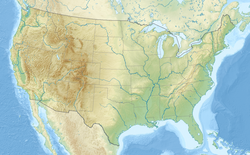The Bell Top Formation is a geologic formation in southern New Mexico.[1] Radiometric dating of surrounding tuffs indicate that it was deposited in the Oligocene epoch.[2]
| Bell Top Formation | |
|---|---|
| Stratigraphic range: | |
| Type | Formation |
| Unit of | Spears Group |
| Underlies | Mogollon Group |
| Overlies | Palm Park Formation, Datil Group |
| Thickness | 800 feet (240 m) |
| Lithology | |
| Primary | Volcaniclastic |
| Location | |
| Coordinates | 32°29′47″N 107°07′05″W / 32.4963°N 107.1181°W |
| Region | New Mexico |
| Country | United States |
| Type section | |
| Named for | Bell Top Mountain |
| Named by | Kottlowski |
| Year defined | 1953 |
Description
editThe formation consists of tuffaceous sandstone and minor conglomerate.[1][2] These are interbedded with volcanic tuffs and flows that are assigned to the Mogollon Group.[2] Total thickness may be as much as 800 feet (240 m).[1] In the southeastern part of the Mogollon-Datil volcanic field, the upper beds of the Bell Top Formation define the break between the Mogollon Group and the Datil Group. Here the Bell Top rests on the 33.51 Ma Box Canyon Tuff, the uppermost unit of the Datil Group, and below the 28.56 Ma Vicks Peak Tuff, the lowest tuff of the Mogollon Group.[2] In other locations, it overlies the Palm Park Formation.[3]
The formation has been interpreted as sediments eroded from caldera rims of the Mogollon-Datil volcanic field.[4] Oxygen isotope ratios suggest that the magma from which the caldera rims solidified had its origin in the Earth's crust as a partial melt of granite source rock.[5]
History of investigation
editThe formation was first named by F.E. Kottlowski in 1953 for exposures around Bell Top Mountain, northwest of Las Cruces, New Mexico. His definition included both igneous beds and sedimentary beds in the formation.[1] Steven M. Cather and his coinvestigators argued in 1994 for a revision of southwestern New Mexico stratigraphy in which the Bell Top Formation was restricted to the sedimentary beds and included in the Spears Group.[2]
Footnotes
editReferences
edit- Cather, Steven M.; Chamberlin, R.M.; Ratte, J.C. (1994). "Tertiary stratigraphy and nomenclature for western New Mexico and eastern Arizona" (PDF). New Mexico Geological Society Field Conference Series. 45: 259–266. Retrieved 25 August 2020.
- Hoffman, M.; Michelfelder, G.S. (2018). "Oxygen isotope variations in Paleogene volcanic rocks from southern New Mexico: Insight on crustal contamination and magmatic sources" (PDF). New Mexico Geological Society Field Conference Series. 69: 189–196. Retrieved 11 March 2021.
- Kottlowski, F.E. (1953). "Tertiary-Quaternary sediments of the Rio Grande Valley in southern New Mexico" (PDF). New Mexico Geological Society Field Conference Guidebook. 4: 144–148. Retrieved 17 May 2020.
- Seager, William R. (1 November 1973). "Resurgent Volcano-Tectonic Depression of Oligocene Age, South-Central New Mexico". GSA Bulletin. 84 (11): 3611–3626. Bibcode:1973GSAB...84.3611S. doi:10.1130/0016-7606(1973)84<3611:RVDOOA>2.0.CO;2.
- Seager, William R.; Clemons, Russel E. (1973). "Middle to late Tertiary geology of Cedar Hills-Selden Hills area, New Mexico" (PDF). New Mexico Bureau of Mines and Mineral Resources Circular. 133. Retrieved 26 August 2020.

